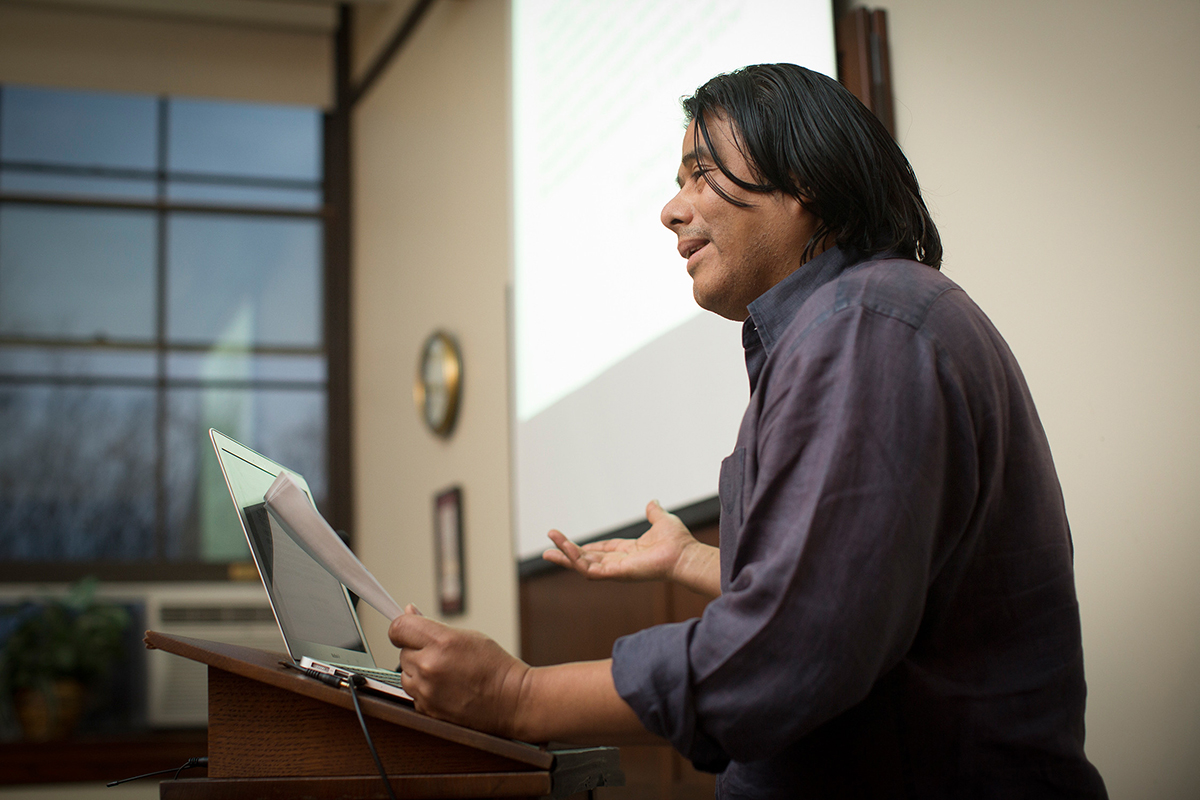Quiñonez on influence: Stories 'made to be stolen'
By Daniel Aloi

Fiction writer and associate professor of English Ernesto Quiñonez began a recent talk with a plot summary of “a story told by the neighbor.”
“It’s about a reclusive man who lives in a mansion. The man appears to be a gentleman, but his manners are not quite there.” He claims to come from old money, and could be hiding something, Quiñonez said.
“We learn that this man had once been in love with a rich, spoiled, brattish, temper-throwing woman, who actually had been in love with him but did not marry him,” because he lacked social status and education, he said.
The man had disappeared before the story begins, has now returned, and is wealthy – “and his only goal is to take back the love of this woman who had scorned him, had left him, for a richer man.”
Quiñonez then reveals that this story is “Wuthering Heights” by Emily Bronte – though his listeners would be correct to assume it to be F. Scott Fitzgerald’s “The Great Gatsby.”
His talk in Goldwin Smith Hall’s English Department Lounge, “The Fingerprints of Influence,” was off and running.
“These stories are basically archetypes – boy meets girl, boy loses girl, boy gets girl again, they die, they become ghosts, or one of them dies and one doesn’t die – but they’re basically blueprints,” he said. “My point on influence is that characters, plots, scenes, themes, stories themselves, were made to be stolen. We have been ripping off the Greeks, and other cultures’ myths, for centuries.”
Fitzgerald himself admitted to having stolen parts of Trimalchio, a character in first-century Roman author Petronius’ “The Satyricon,” in creating Jay Gatsby, Quiñonez said.
“What exactly is the quintessential novel of the past century but a brilliant retelling of a Homeric myth?” he said.
Among the similarities between Bronte’s novel and Fitzgerald’s, he said: “It is interesting to note that in both novels they start at the lawn where these characters live. Bronte’s Mr. Lockwood and Heathcliff could be mistaken for Nick Carraway and Gatsby. And in both novels, Mr. Lockwood and Nick Carraway are pathetic, peripheral, passive narrators. They are not really involved in the story, and are basically outsiders, looking in.”
He also compared Richard Wright’s “Native Son,” published in 1940, and Albert Camus’ “The Stranger,” published in 1942. Wright’s protagonist, Bigger Thomas, is 20, black, and an inevitable victim of poverty and circumstance on Chicago’s south side. Camus’ protagonist is Meursault, a white Algerian. Both Bigger and Meursault are indifferent, unmotivated, alienated from their mothers; and both are tried and condemned for committing murder.
“Both novels have almost identical scenes,” he said. “I will only point out one, when both the protagonists are visited in their cells by a holy man. In both scenes you have a slow buildup of disgust and rejection towards the holy man – for Bigger he is a pastor, for Meursault, a Jesuit priest.”
Also, in the first draft of Camus’ novel, “there was no murder, no mother, no trial,” he said.
While saying that intertextual comparisons between such works is “cheap and easy,” Quiñonez also contended: “Originality isn’t just overrated – it doesn’t really exist. We as writers, what we do is basically bring our own fingerprints to a work. These fingerprints include our own philosophies, ethnicities, backgrounds, gender and personal politics, upbringings – but all this acts as a mask to basically cover up stories that have been told, retold and told again in the pawnshops of storytelling.”
He ended his presentation by showing brief, similar scenes from two films: Ingmar Bergman’s “Cries and Whispers” and Woody Allen’s “Interiors,” and taking questions.
Quiñonez is the author of the novels “Bodega Dreams” (2000) – a Notable Book selection of The New York Times and Los Angeles Times – and “Chango’s Fire” (2004), and was a visiting writer at the Sundance Screenwriters’ Lab in 2013.
“His influences are everywhere. It’s a natural organic progression of self-expression raising from the very pavements of our cities,” said professor of English and Creative Writing Program Director Helena María Viramontes in her introduction. “His literary roots run deep and wide, from Camus to Márquez … and his love of literature remains as powerful as his work.”
The talk was part of “In A Word,” which showcases writers on the English and Creative Writing Program faculty. In the spring, the series will feature poet Lyrae Van Clief-Stefanon in conversation with Dagmawi Woubshet.
Media Contact
Get Cornell news delivered right to your inbox.
Subscribe